A 3D Non-Linear FE Model and Optimization of Cavity Die Sheet Hydroforming Process
Abstract
:1. Introduction
2. Methodology
3. Results and Discussions
Development of Mathematical Model
4. Conclusions
- A nonlinear 3D FE model for the CDSHF process of high-strength cryo-rolled AA5083 (aluminum alloy) was developed and validated using experimental work published in the literature;
- Square cups were created through deep drawing using the CDSHF process. The initial process parameters considered were FP 0–24 MPa, BHF 0–310 kN, FR 7 mm, and a CoF of 0.04 between die and blank. The depth of the formed square cup obtained is 35 mm, the corner radius is 16.7 mm, and the thinning percentage is 7.24;
- We formed square cups with better formability by lowering the peak FP to 22 MPa, holding this peak FP for 30 s, and following an unloading path. A 35 mm deep square cup was produced with a die corner radius of 16.1 mm and a thinning percentage of 5.5;
- A mathematical model was developed, and multi-objective optimization was performed to minimize material thinning and corner radius. RSM was used to establish the model. The input parameters considered were FP 20–22 MPa, BHF 260–300 kN, CoF between die and blank 0.04–0.12, and FR 5–7 mm;
- FP was found to be the most influencing parameter. The interaction effects of input parameters on output were also studied. ANOVA was used to validate this RSM-based mathematical model, and the model was found significant (“model p-value” < 0.001);
- The optimal values obtained from the RSM-based mathematical model are CoF of 0.04, BHF of 260 kN, peak FP of 21.41 MPa, and FR 5 mm. This model predicted a thinning percentage of 5.27 and a corner radius of 18.64 mm. The optimum input values were used in the FE simulations, and similar results were obtained. The FE model has a thinning percentage of 5.48 and a corner radius of 19.03 mm.
Author Contributions
Funding
Data Availability Statement
Conflicts of Interest
Abbreviations
| Nomenclature/ Abbreviation | Description |
| FE | Finite element |
| CDSHF | Cavity die sheet hydroforming |
| FP | Fluid pressure |
| ALE | Arbitrary Lagrangian–Eulerian |
| CoF | Coefficient of friction |
| BHF | Blank holding force |
| FR | Flange radius |
| RSM | Response surface methodology |
| YS | Yield strength |
| UTS | Ultimate tensile strength |
| Elng. (%) | Percentage elongation |
| n | Strain hardening index |
| K | Strength coefficient |
| CCD | Central composite design |
| ANOVA | Analysis of variance |
| Cor. Rad. | Corner radius |
| % Thin. | Percentage thinning |
References
- Bell, C.; Corney, J.; Zuelli, N.; Savings, D. A state of the art review of hydroforming technology: Its applications, research areas, history, and future in manufacturing. Int. J. Mater. Form. 2020, 13, 789–828. [Google Scholar] [CrossRef]
- Hartl, C. Research and advances in fundamentals and industrial applications of hydroforming. J. Mater. Process. Technol. 2005, 167, 383–392. [Google Scholar] [CrossRef]
- Lang, L.H.; Wang, Z.R.; Kang, D.C.; Yuan, S.J.; Zhang, S.H.; Danckert, J.; Nielsen, K.B. Hydroforming highlights: Sheet hydroforming and tube hydroforming. J. Mater. Process. Technol. 2004, 151, 165–177. [Google Scholar] [CrossRef]
- Palumbo, G.; Zhang, S.H.; Tricarico, L.; Xu, C.; Zhou, L.X. Numerical/experimental investigations for enhancing the sheet hydroforming process. Int. J. Mach. Tools Manuf. 2006, 46, 1212–1221. [Google Scholar] [CrossRef]
- Hwang, Y.M.; Manabe, K.I. Latest hydroforming technology of metallic tubes and sheets. Metals 2021, 11, 1360. [Google Scholar] [CrossRef]
- Feyissa, F.T.; Kumar, D.R. Enhancement of drawability of cryorolled AA5083 alloy sheets by hydroforming. J. Mater. Res. Technol. 2019, 8, 411–423. [Google Scholar] [CrossRef]
- Modi, B.; Kumar, D.R. Development of a hydroforming setup for deep drawing of square cups with variable blank holding force technique. Int. J. Adv. Manuf. Technol. 2013, 66, 1159–1169. [Google Scholar] [CrossRef]
- Raj, A.B.; Arun, A.; Ramesh, A. Finite Element Modelling and Optimisation of Sheet Hydroforming for Cryo-rolled AA5083 Sheets. In Lecture Notes in Mechanical Engineering; Springer: Singapore, 2021; pp. 931–942. [Google Scholar] [CrossRef]
- Ahamed, J.F.A.; Chinnaiyan, P. Parametric Optimization in Hydroforming of Nimonic 90 Sheet using Cuckoo Search and Particle Swarm Optimization. Int. J. Eng. Trends Technol. 2023, 71, 148–158. [Google Scholar] [CrossRef]
- Nguyen, T.T.; Nguyen, T.D. A Study on the Impact of Blank Holder Pressure on Forming Pressure and Product Quality in Hydrostatic Forming. Int. J. Precis. Eng. Manuf. 2023, 24, 187–198. [Google Scholar] [CrossRef]
- Ballikaya, H.; Savas, V.; Ozay, C. The limit drawing ratio in die angled hydromechanical deep drawing method. Int. J. Adv. Manuf. Technol. 2020, 106, 791–801. [Google Scholar] [CrossRef]
- Chinnaraj, K.; Padmanaban, R. Analytical Prediction of Residual Stresses in Cold Formed Steel Sections with Elastic—Perfectly Plastic Material Model. In SAE Technical Papers; SAE International: Warrendale, PA, USA, 2017. [Google Scholar] [CrossRef]
- Liu, X.J.; Ma, X.F.; Li, C.; Qin, J.; Chen, P. Construction of aluminum alloy constitutive model based on BP neural network and the study of non-isothermal hydroforming. Int. J. Adv. Manuf. Technol. 2022, 120, 8259–8274. [Google Scholar] [CrossRef]
- Wang, H.; Cheng, S.; Ye, Z.; Wu, T.; Jin, K.; Guo, X. Evaluation of the formability of AA2198-T3 Al-Li alloy in warm sheet hydroforming. Int. J. Adv. Manuf. Technol. 2022, 118, 405–416. [Google Scholar] [CrossRef]
- Koç, M. Hydroforming for Advanced Manufacturing; Woodhead Publishing Ltd.: Cambridge, UK, 2008; pp. i–iii. ISBN 9781845693282. [Google Scholar]
- Akay, S.B.; Halkacı, H.S.; Öztürk, E.; Öztürk, O.; Ataş, G.; Aydın, M.; Türköz, M.; Dilmeç, M. Numerical and experimental investigation of the effect of double-sided hydroforming process on wrinkling damage by optimizing loading curves with adaptive control. Int. J. Adv. Manuf. Technol. 2022, 121, 2149–2168. [Google Scholar] [CrossRef]
- Xiang, N.; Huang, T.; Wang, P.Y.; Zheng, L.H.; Guo, J.Q.; Guo, X.H.; Chen, F.X. Increased sheet-forming capability via controlling in-plane stress state of the sheet metal using hetero-structured flexible dies. Int. J. Adv. Manuf. Technol. 2022, 120, 3491–3506. [Google Scholar] [CrossRef]
- Han, Z.; Wei, C.; Du, S.; Jia, Z.; Du, X. Numerical simulation and experimental research on rubber flexible-die forming limitation with new position-limited backpressure mechanism. Int. J. Adv. Manuf. Technol. 2021, 116, 2183–2196. [Google Scholar] [CrossRef]
- Sun, Z.; Lang, L. Effect of stress distribution on springback in hydroforming process. Int. J. Adv. Manuf. Technol. 2017, 93, 2773–2782. [Google Scholar] [CrossRef]
- Churiaque, C.; Sánchez-Amaya, J.M.; Caamaño, F.; Vazquez-Martinez, J.M.; Botana, J. Springback Estimation in the Hydroforming Process of UNS A92024-T3 Aluminum Alloy by FEM Simulations. Metals 2018, 8, 404. [Google Scholar] [CrossRef]
- Nagaraja, S.R.; Prasad, J.K.; Jagadeesh, G. Theoretical-experimental study of shock wave-assisted metal forming process using a diaphragmless shock tube. Proc. Inst. Mech. Eng. Part G J. Aerosp. Eng. 2012, 226, 1534–1543. [Google Scholar] [CrossRef]
- Zhang, S.; Luo, X.; Zheng, G.Y.; Hu, R.; Wang, H.; Li, M.H. Evolutions of Microstructure and Mechanical Properties of Cryorolled 7085 Al Alloy After Annealing Treatments. JOM 2023, 75, 2462–2472. [Google Scholar] [CrossRef]
- Feyissa, F.; Urnendu Das, P.; Ravi Kumar, D.; Ravi Sankar, B. Characterization of Mechanical Properties and Formability of Cryorolled Aluminium Alloy Sheets. In Proceedings of the 5th International & 26th All India Manufacturing Technology, Design and Research Conference (AIMTDR 2014), IIT Guwahati, Assam, India, 12–14 December 2014; pp. 5111–5116. [Google Scholar]
- Feyissa, F.; Ravi Kumar, D.; Rao, P.N. Characterization of Microstructure, Mechanical Properties and Formability of Cryorolled AA5083 Alloy Sheets. J. Mater. Eng. Perform. 2018, 27, 1614–1627. [Google Scholar] [CrossRef]
- Satish, D.R.; Feyissa, F.T.; Kumar, D.R. Formability of Cryorolled Aluminum Alloy Sheets in Warm Forming. Int. J. Mater. Mech. Manuf. 2018, 6, 123–126. [Google Scholar] [CrossRef]
- Raut, S.V.; Ramesh, A.; Arun, A.; Sumesh, C.S. Finite element analysis and optimization of tube hydroforming process. Mater. Today Proc. 2021, 46, 5008–5016. [Google Scholar] [CrossRef]
- Haridas, M.; Gopal, G.; Ramesh, A.; Katta, R.K. Modelling and simulation of single and multi-pass flow forming to investigate the influence of process parameters on part accuracy. Int. J. Manuf. Res. 2016, 11, 274–289. [Google Scholar] [CrossRef]
- Barrett, T.J.; Knezevic, M. Deep drawing simulations using the finite element method embedding a multi-level crystal plasticity constitutive law: Experimental verification and sensitivity analysis. Comput. Methods Appl. Mech. Eng. 2019, 354, 245–270. [Google Scholar] [CrossRef]
- Sumesh, C.S.; Akbar, D.S.; Purandharadass, H.S.; Chandrasekaran, R.J. Optimization of dimensional tolerances and material removal rate in the orthogonal turning of AISI 4340 steel. Period. Polytech. Mech. Eng. 2021, 65, 205–216. [Google Scholar] [CrossRef]
- Kuppusamy, A.; Rameshkumar, K.; Sumesh, A.; Premkumar, S. Gas Metal Arc Welding Process Parameter Optimization to Reduce Porosity Defect in a Longitudinal Seam Welding of Pressure Vessels. SAE Int. J. Mater. Manuf. 2019, 13, 61–79. [Google Scholar] [CrossRef]
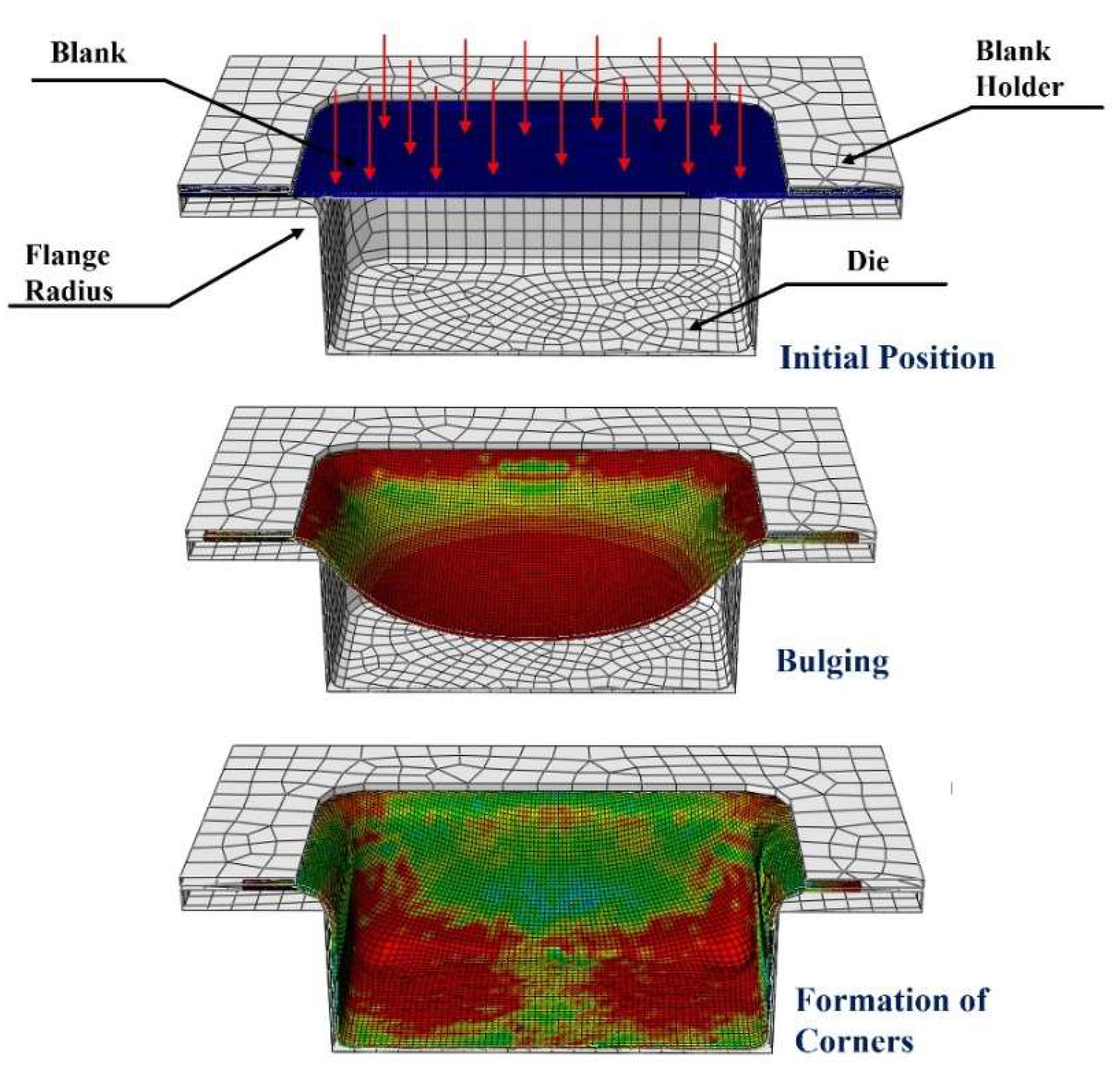
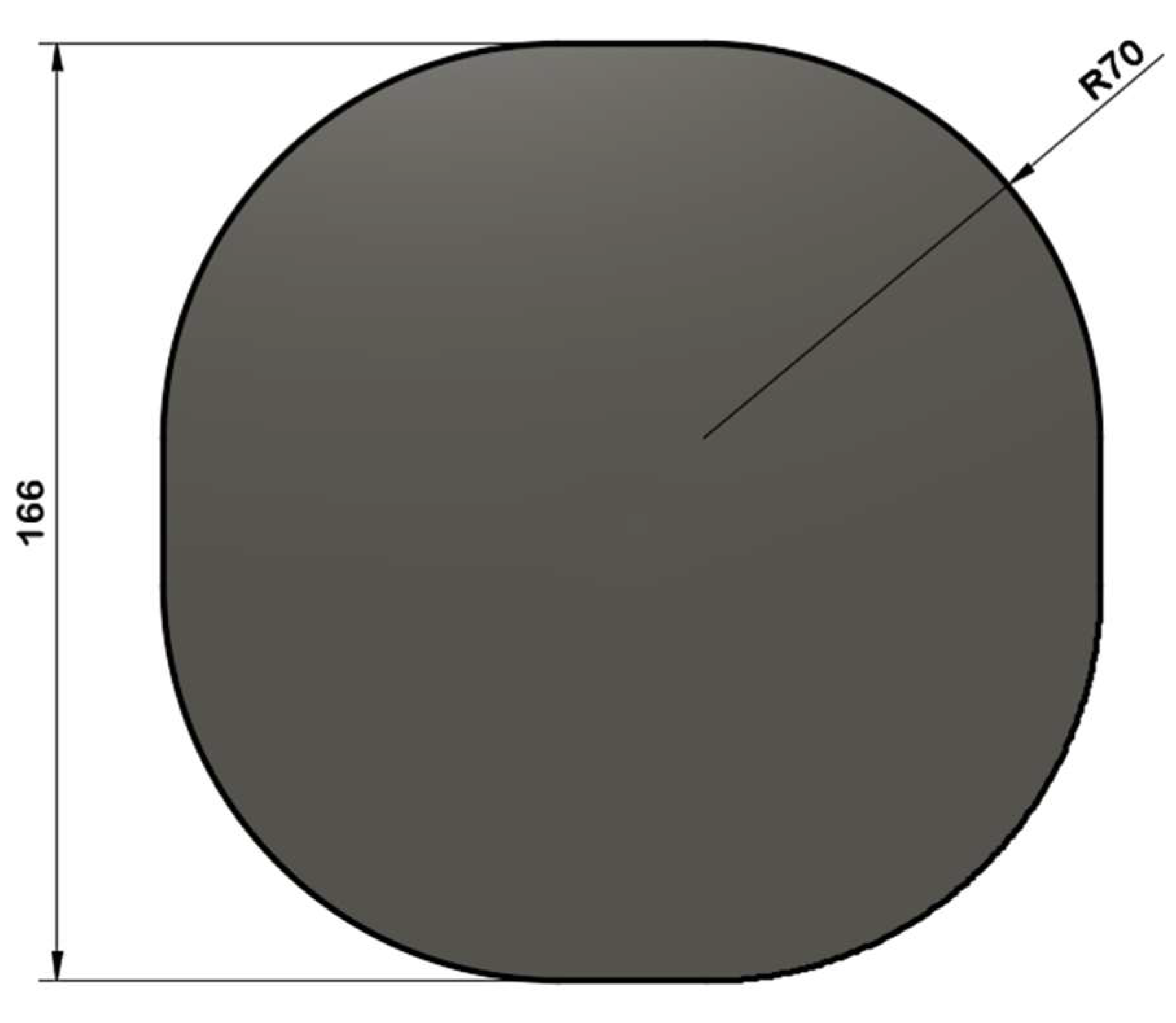
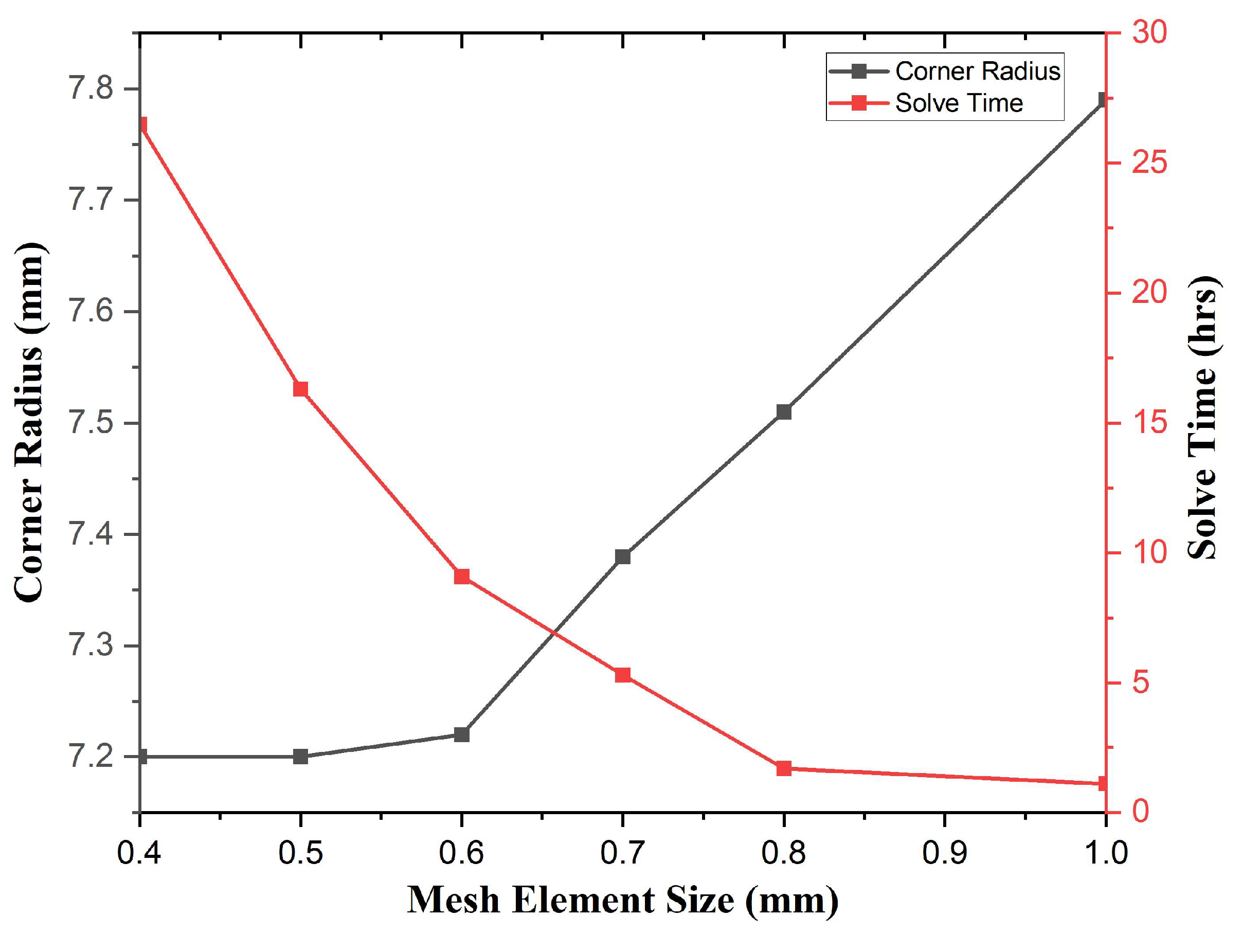

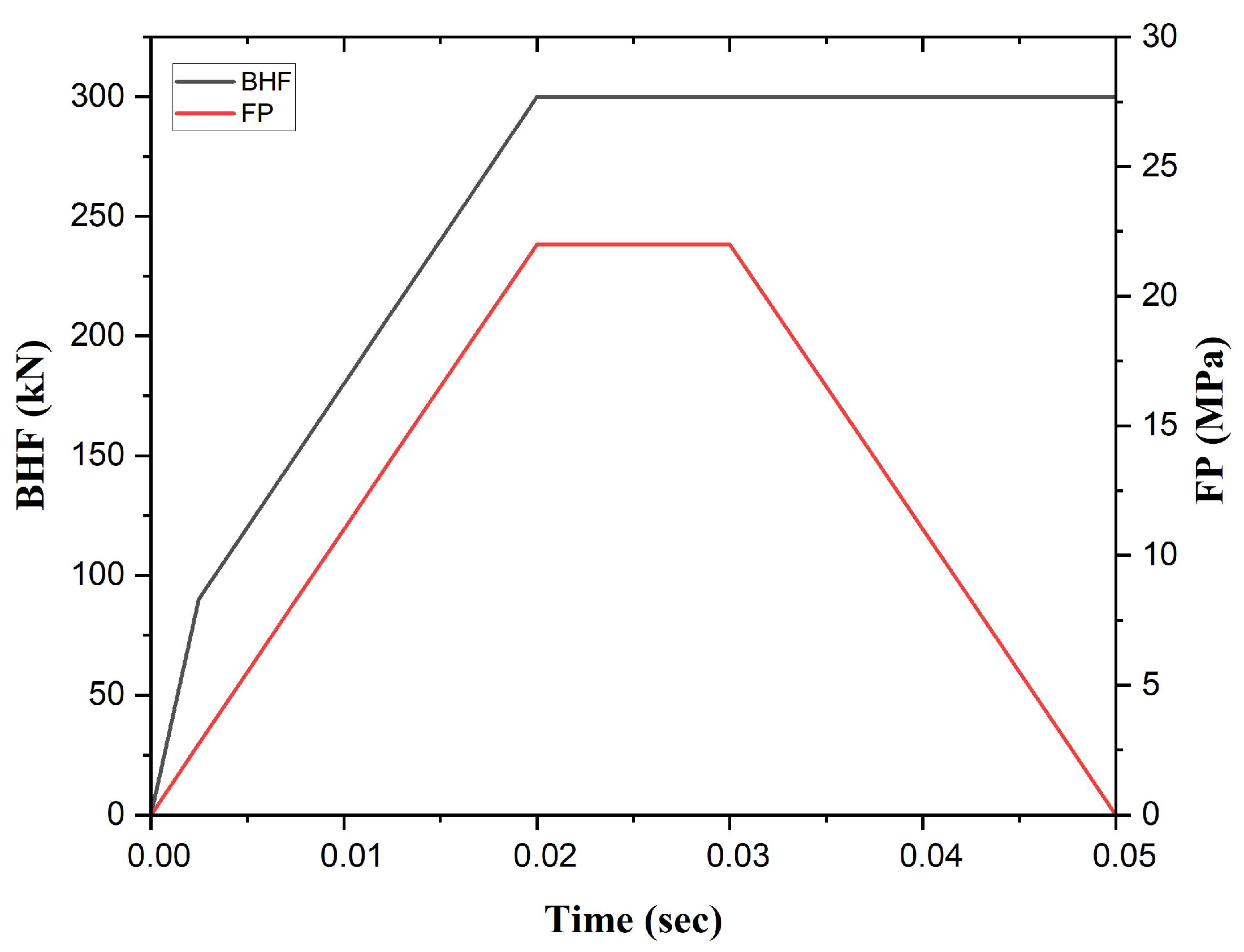
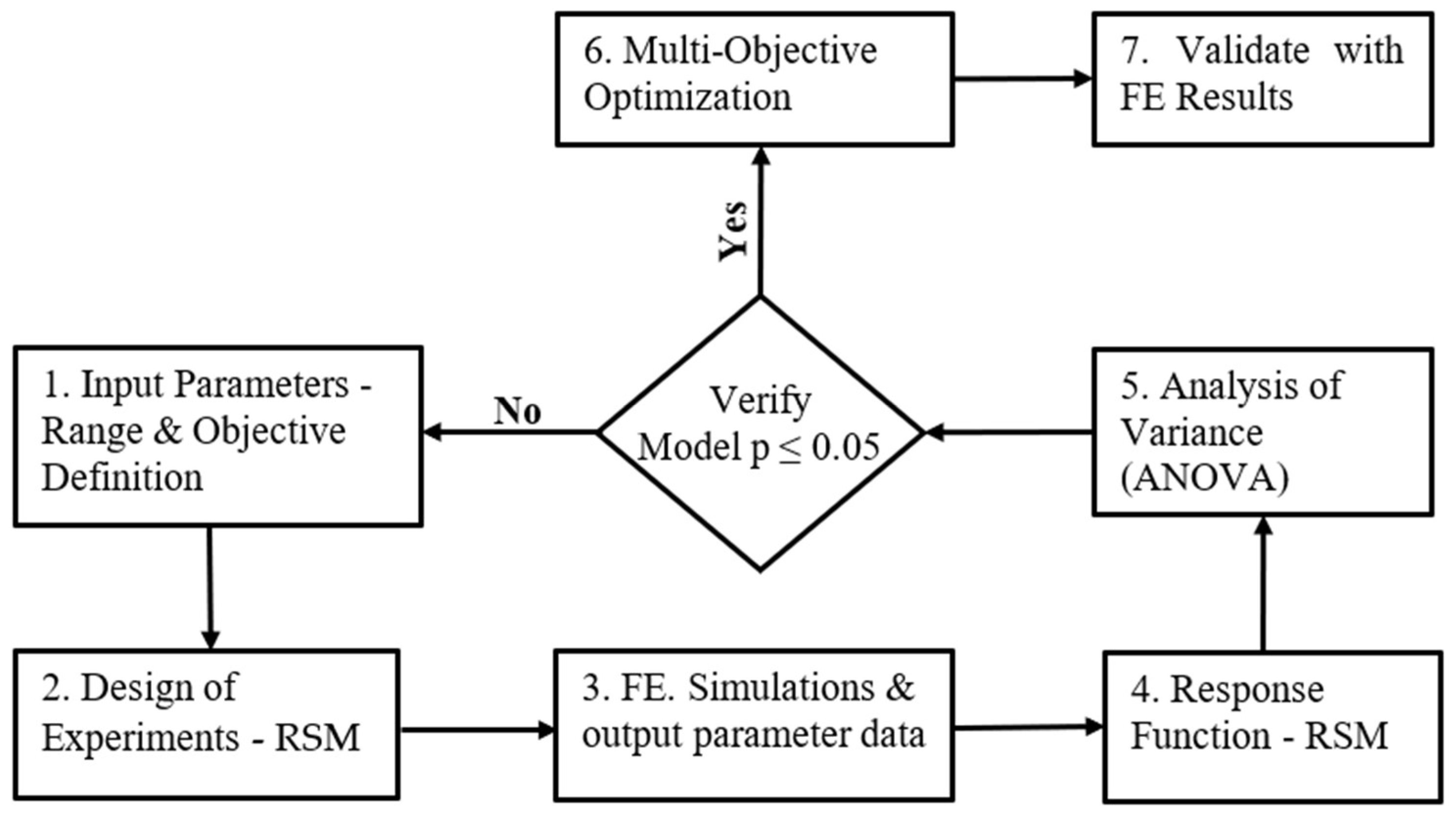
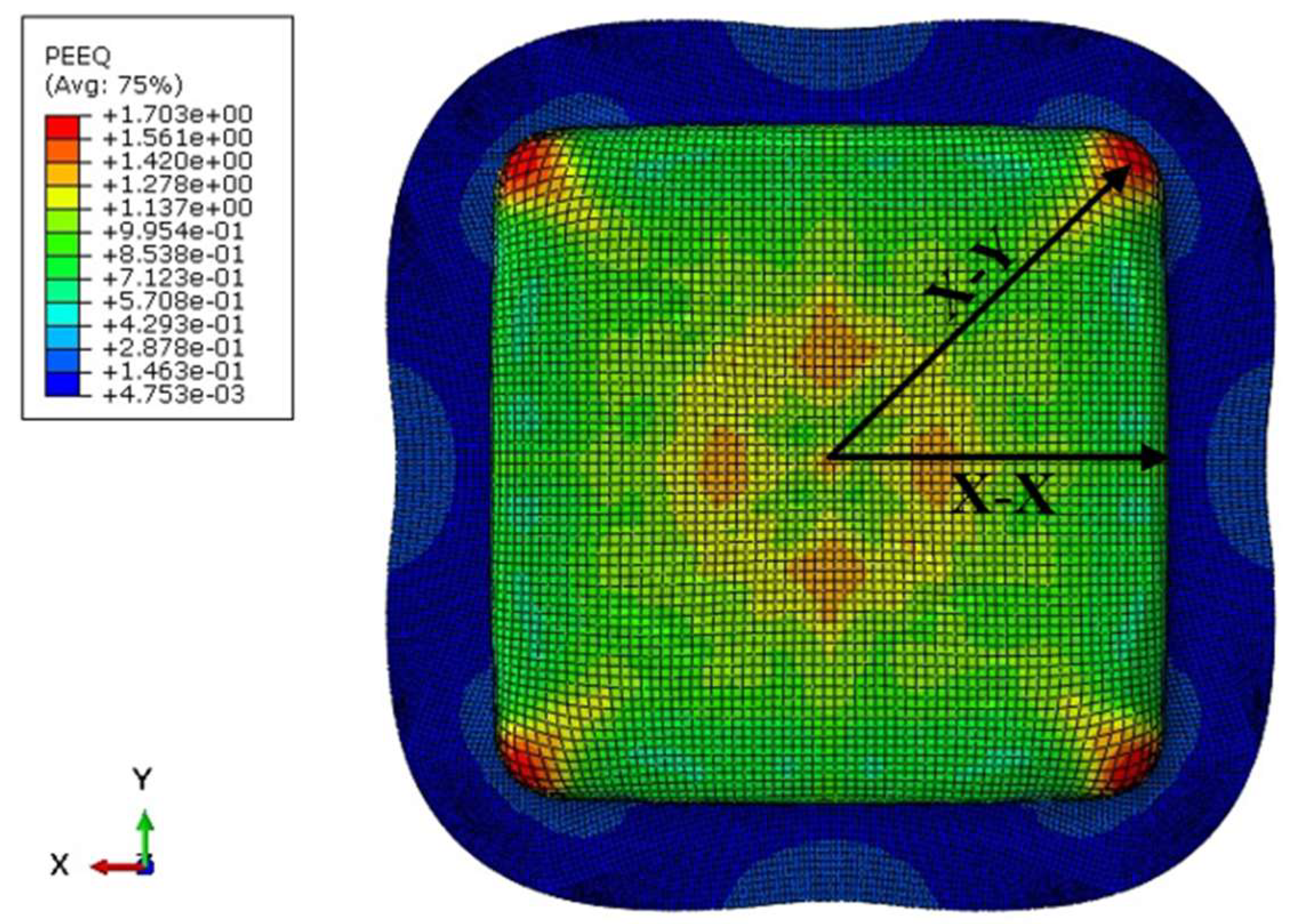
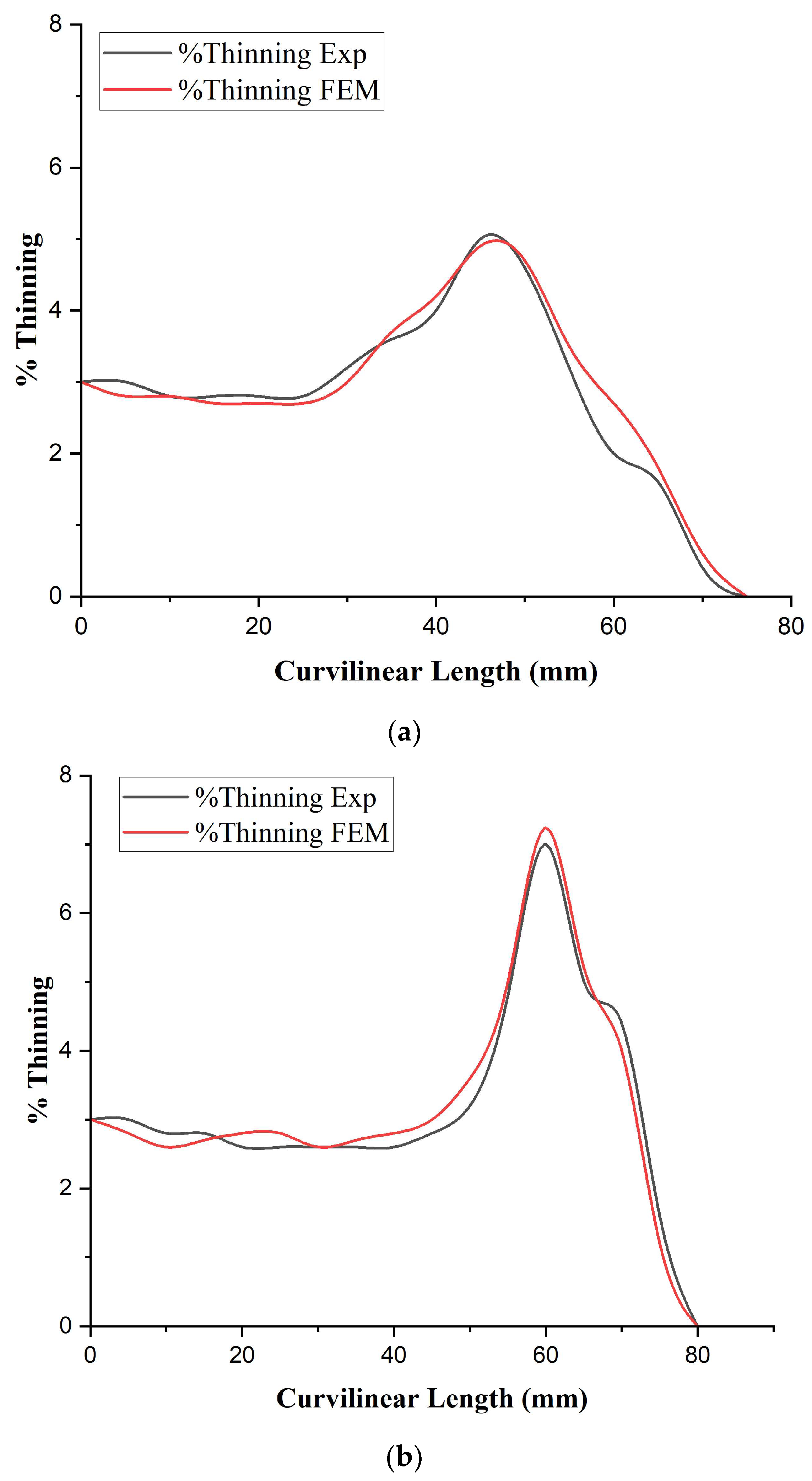

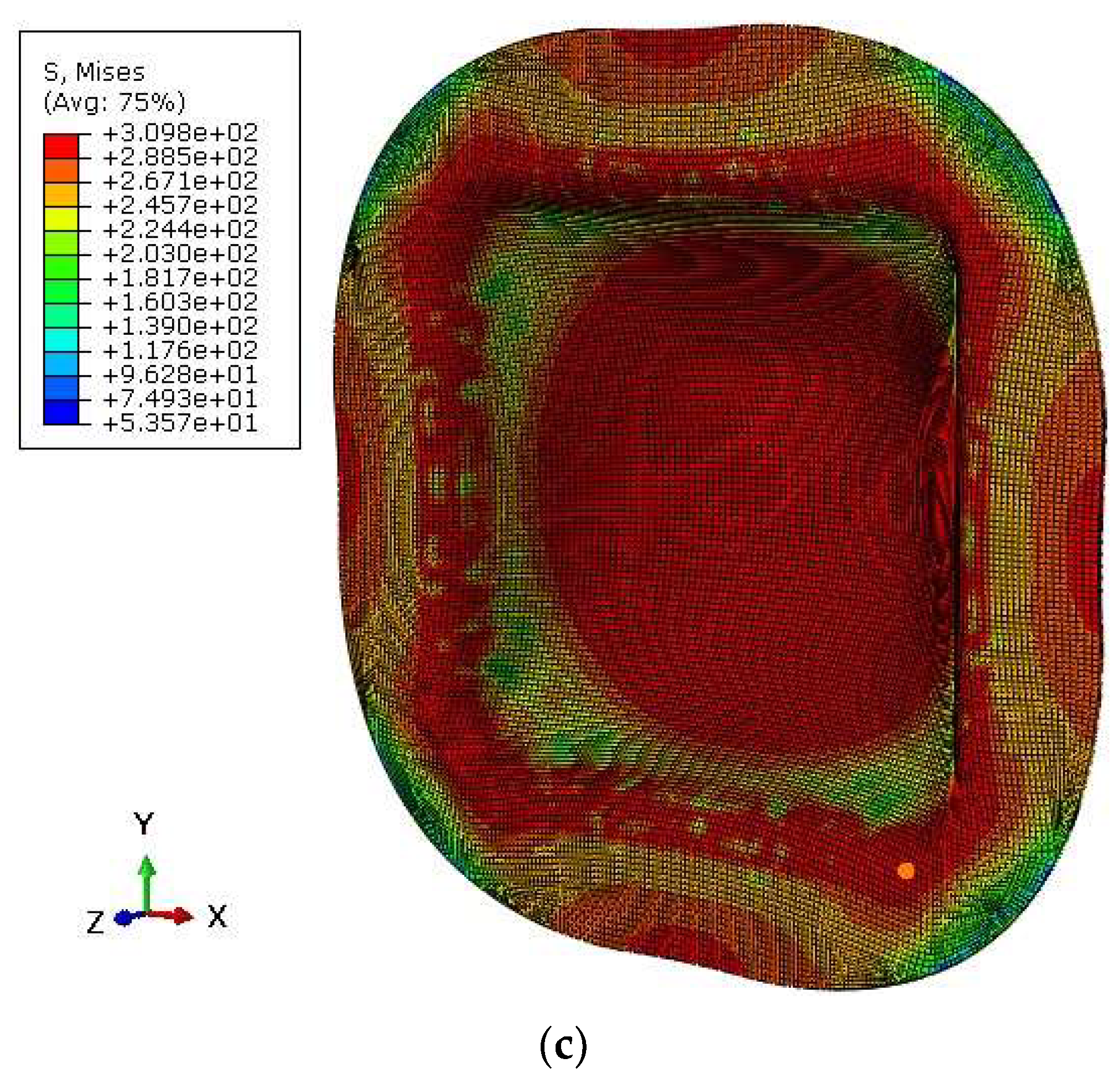

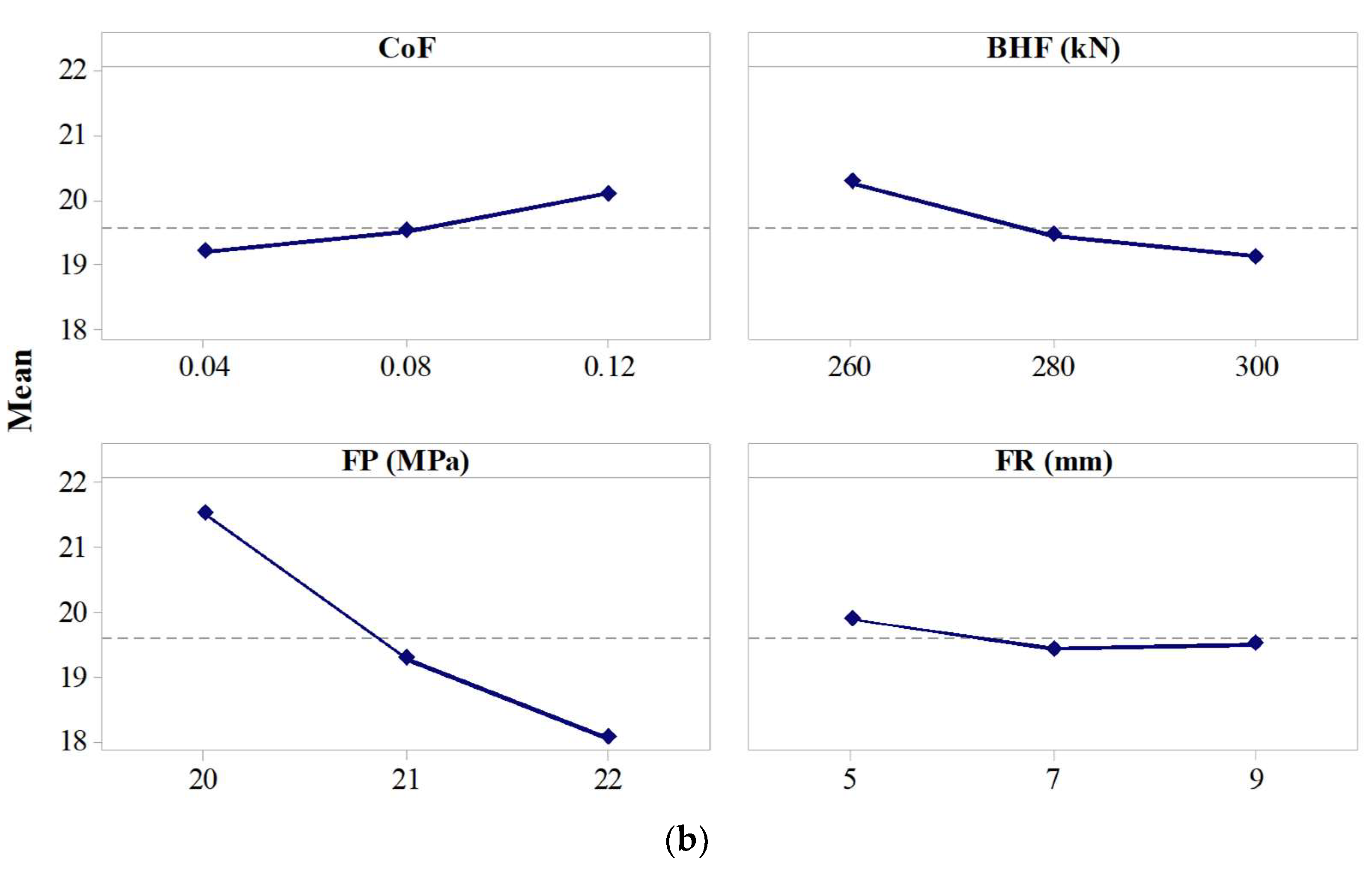
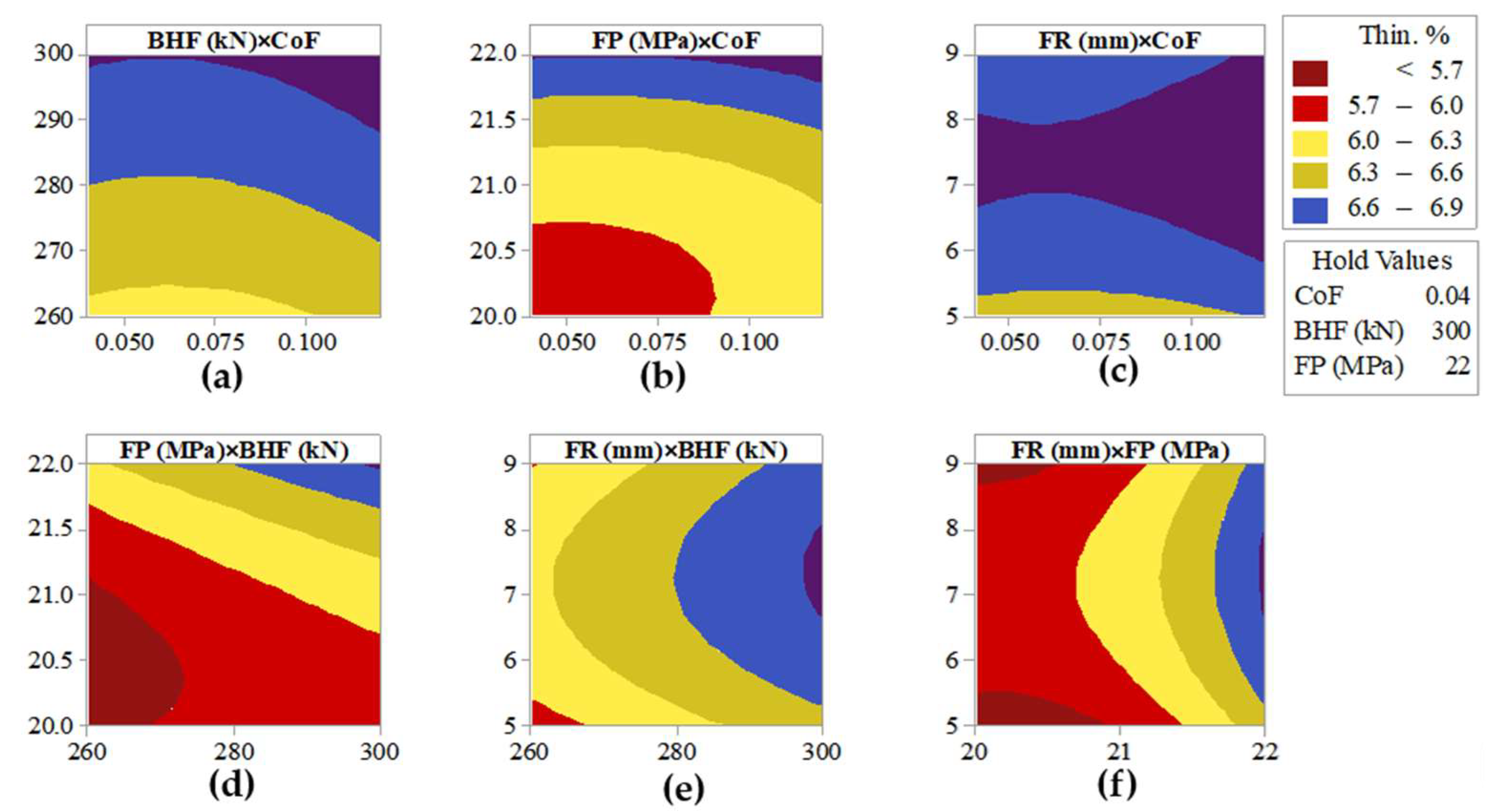

| Mg | Mn | Fe | Si | Cu | Cr | Zn | Al |
|---|---|---|---|---|---|---|---|
| 4.256 | 0.542 | 0.221 | 0.258 | 0.047 | 0.086 | 0.030 | Balance |
| YS (MPa) | UTS (MPa) | Elng. (%) | n | K (MPa) |
|---|---|---|---|---|
| 186.1 | 309.8 | 18.1 | 0.243 | 533 |
| Input Parameters | CoF | FP (MPa) | BHF (kN) | FR (mm) |
|---|---|---|---|---|
| Low Level | 0.04 | 20 | 260 | 5 |
| High Level | 0.12 | 22 | 300 | 9 |
| FE Model Results | Experimental Results [6] | % Difference | |
|---|---|---|---|
| Depth (mm) | 35 | 35 | 0 |
| Min. Corner radius (mm) | 16.7 | 16 | 4.37% |
| Thinning % | 7.24 | 7 | 3.32% |
| Input Parameters | Output Parameters | |||||
|---|---|---|---|---|---|---|
| Sl. No. | CoF | BHF (kN) | FP (MPa) | FR (mm) | Thin. % | Cor. Rad. (mm) |
| 01 | 0.04 | 260 | 20 | 5 | 5.5 | 22.3 |
| 02 | 0.08 | 280 | 21 | 5 | 5.5 | 19.8 |
| 03 | 0.12 | 300 | 22 | 5 | 6.4 | 17.9 |
| 04 | 0.12 | 260 | 20 | 5 | 5.5 | 22.3 |
| 05 | 0.12 | 300 | 20 | 5 | 5.9 | 21.3 |
| 06 | 0.12 | 260 | 22 | 5 | 6.1 | 19.3 |
| 07 | 0.04 | 260 | 22 | 5 | 5.7 | 18.2 |
| 08 | 0.04 | 300 | 20 | 5 | 5.6 | 20.8 |
| 09 | 0.04 | 300 | 22 | 5 | 6.6 | 17.2 |
| 10 | 0.08 | 300 | 21 | 7 | 6.2 | 19.2 |
| 11 | 0.08 | 280 | 21 | 7 | 5.9 | 19.3 |
| 12 | 0.08 | 280 | 22 | 7 | 7.0 | 19.0 |
| 13 | 0.08 | 260 | 21 | 7 | 5.7 | 19.6 |
| 14 | 0.08 | 280 | 20 | 7 | 5.5 | 21.7 |
| 15 | 0.12 | 280 | 21 | 7 | 6.4 | 20.0 |
| 16 | 0.04 | 280 | 21 | 7 | 5.7 | 18.0 |
| 17 | 0.12 | 260 | 20 | 9 | 5.4 | 22.2 |
| 18 | 0.12 | 300 | 20 | 9 | 6.2 | 21.2 |
| 19 | 0.04 | 300 | 20 | 9 | 5.4 | 20.1 |
| 20 | 0.04 | 260 | 20 | 9 | 5.6 | 21.9 |
| 21 | 0.04 | 260 | 22 | 9 | 5.8 | 17.5 |
| 22 | 0.12 | 300 | 22 | 9 | 6.7 | 17.6 |
| 23 | 0.12 | 260 | 22 | 9 | 6.2 | 19.1 |
| 24 | 0.08 | 280 | 21 | 9 | 5.8 | 19.2 |
| 25 | 0.04 | 300 | 22 | 9 | 6.9 | 16.8 |
Disclaimer/Publisher’s Note: The statements, opinions and data contained in all publications are solely those of the individual author(s) and contributor(s) and not of MDPI and/or the editor(s). MDPI and/or the editor(s) disclaim responsibility for any injury to people or property resulting from any ideas, methods, instructions or products referred to in the content. |
© 2024 by the authors. Licensee MDPI, Basel, Switzerland. This article is an open access article distributed under the terms and conditions of the Creative Commons Attribution (CC BY) license (https://creativecommons.org/licenses/by/4.0/).
Share and Cite
Achuthankutty, A.; Ramesh, A.; Velamati, R.K. A 3D Non-Linear FE Model and Optimization of Cavity Die Sheet Hydroforming Process. Metals 2024, 14, 478. https://doi.org/10.3390/met14040478
Achuthankutty A, Ramesh A, Velamati RK. A 3D Non-Linear FE Model and Optimization of Cavity Die Sheet Hydroforming Process. Metals. 2024; 14(4):478. https://doi.org/10.3390/met14040478
Chicago/Turabian StyleAchuthankutty, Arun, Ajith Ramesh, and Ratna Kishore Velamati. 2024. "A 3D Non-Linear FE Model and Optimization of Cavity Die Sheet Hydroforming Process" Metals 14, no. 4: 478. https://doi.org/10.3390/met14040478





